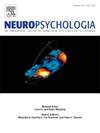Primary manipulation knowledge of objects is associated with the functional coupling of pMTG and aIPS
IF 2
3区 心理学
Q3 BEHAVIORAL SCIENCES
引用次数: 0
Abstract
Correctly using hand-held tools and manipulable objects typically relies not only on sensory and motor-related processes, but also centrally on conceptual knowledge about how objects are typically used (e.g. grasping the handle of a kitchen knife rather than the blade avoids injury). A wealth of fMRI connectivity-related evidence demonstrates that contributions from both ventral and dorsal stream areas are important for accurate tool knowledge and use. Here, we investigate the combined role of ventral and dorsal stream areas in representing “primary” manipulation knowledge - that is, knowledge that is hypothesized to be of central importance for day-to-day object use. We operationalize primary manipulation knowledge by extracting the first dimension from a multi-dimensional scaling solution over a behavioral judgement task where subjects arranged a set of 80 manipulable objects based on their overall manipulation similarity. We then relate this dimension to representational and time-course correlations between ventral and dorsal stream areas. Our results show that functional coupling between posterior middle temporal gyrus (pMTG) and anterior intraparietal sulcus (aIPS) is uniquely related to primary manipulation knowledge about objects, and that this effect is more pronounced for objects that require precision grasping. We reason this is due to precision-grasp objects requiring more ventral/temporal information relating to object shape, material and function to allow correct finger placement and controlled manipulation. These results demonstrate the importance of functional coupling across these ventral and dorsal stream areas in service of manipulation knowledge and accurate grasp-related behavior.
物体的初级操作知识与 pMTG 和 aIPS 的功能耦合有关。
正确使用手持工具和可操作物体通常不仅依赖于感觉和运动相关过程,而且还集中依赖于有关物体通常如何使用的概念性知识(例如,抓住菜刀的刀柄而不是刀刃可避免受伤)。大量与 fMRI 连接性相关的证据表明,来自腹侧流和背侧流区域的贡献对于准确掌握和使用工具非常重要。在这里,我们研究了腹侧流和背侧流区域在代表 "主要 "操作知识方面的综合作用,即假设对日常物品使用具有核心重要性的知识。在一项行为判断任务中,受试者将一组 80 个可操作的物体根据其整体操作相似性进行排列,我们通过从多维缩放解决方案中提取第一个维度来操作初级操作知识。然后,我们将这一维度与腹侧流和背侧流区域之间的表征和时程相关性联系起来。我们的研究结果表明,后颞中回(pMTG)和前顶内沟(aIPS)之间的功能耦合与物体的初级操作知识有着独特的关系,而且这种效应在需要精确抓取的物体上更为明显。我们推断这是由于精确抓取物体需要更多与物体形状、材料和功能相关的腹侧/颞侧信息,以便正确放置手指和控制操作。这些结果表明,这些腹侧流和背侧流区域之间的功能耦合在操作知识和精确抓取相关行为中的重要性。
本文章由计算机程序翻译,如有差异,请以英文原文为准。
求助全文
约1分钟内获得全文
求助全文
来源期刊

Neuropsychologia
医学-行为科学
CiteScore
5.10
自引率
3.80%
发文量
228
审稿时长
4 months
期刊介绍:
Neuropsychologia is an international interdisciplinary journal devoted to experimental and theoretical contributions that advance understanding of human cognition and behavior from a neuroscience perspective. The journal will consider for publication studies that link brain function with cognitive processes, including attention and awareness, action and motor control, executive functions and cognitive control, memory, language, and emotion and social cognition.
 求助内容:
求助内容: 应助结果提醒方式:
应助结果提醒方式:


